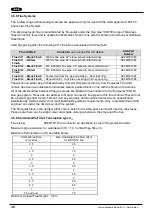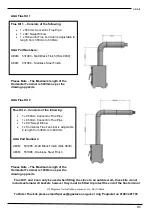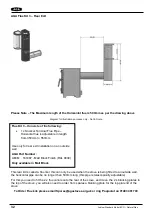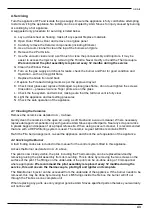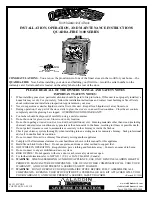
28
Ludlow Standard Model ECG
– Natural Gas
Pictures of Top Exit Flue Collar Fitted with Top Lid Removed & the Relief Valve Flap (RVF)
Picture showing inner only - 100mm exhaust flue
Picture showing both inner & outer
collar fitted for top exit to firebox & Relief Valve Flap
flue collars fitted for top exit & RVF
The Relief Valve Flap (RVF) with Ceramic Gasket - fitted underneath to form an airtight seal
As marked with the White Dot
Please Note
– The Relief Valve Flap (RVF) is fitted on the top of this stove, please make sure this
moves freely up and down on the 2 x dowel pins either side, please check that the ceramic white gasket
is intact and the Relief Valve Flap (RVF) is fully down on the top of the stove and making an air tight
seal. This Relief Valve Flap (RVF) is held down and in place by its own weight only
–
do not place any
object on top of the RVF
3.6.2 Timber Frame Construction
Whilst it is possible to install room-sealed appliances in timber frame properties, great care needs to be
taken to ensure that the flue assembly does not interfere with the weather proofing qualities of any outer
wall which it may penetrate. Before attempting this work, further details need to be referenced, (e.g.
“Gas Installations in Timber Frame Buildings” from the GAS SAFE installer series in the UK).
3.6.3 Carport or Building Extension
Where a flue terminal is sited within a carport or building extension, it should have at least two
completely open and unobstructed sides. The distance between the lowest part of the roof and the top of
the terminal should be at least 600mm.
Note: A covered passageway should not be treated as a carport.
Flues should not be sited
in a covered
passageway between properties.
3.6.4 Basements, Light wells and Retaining walls
Flue terminals should not be sited within the confines of a basement area, light well or external space
formed by a retaining wall, unless steps are taken to ensure the products of combustion can disperse
safely at all times. It may be possible to install this Balanced Flue system in such a location provided that
it is not sited lower than 1m from the top level of that area to allow combustion products to disperse safely.
Flue terminals should be sited to ensure total clearance of the combustion products in accordance with
the included information. When the products of combustion are discharged, they should not cause a
nuisance to adjoining or adjacent properties and they should be positioned so that damage cannot occur
to other parts of the building. If the outer wall surface is constructed of combustible material, a non-
combustible plate should be fitted behind the terminal projecting 25mm beyond the external edges of the
terminal.

















